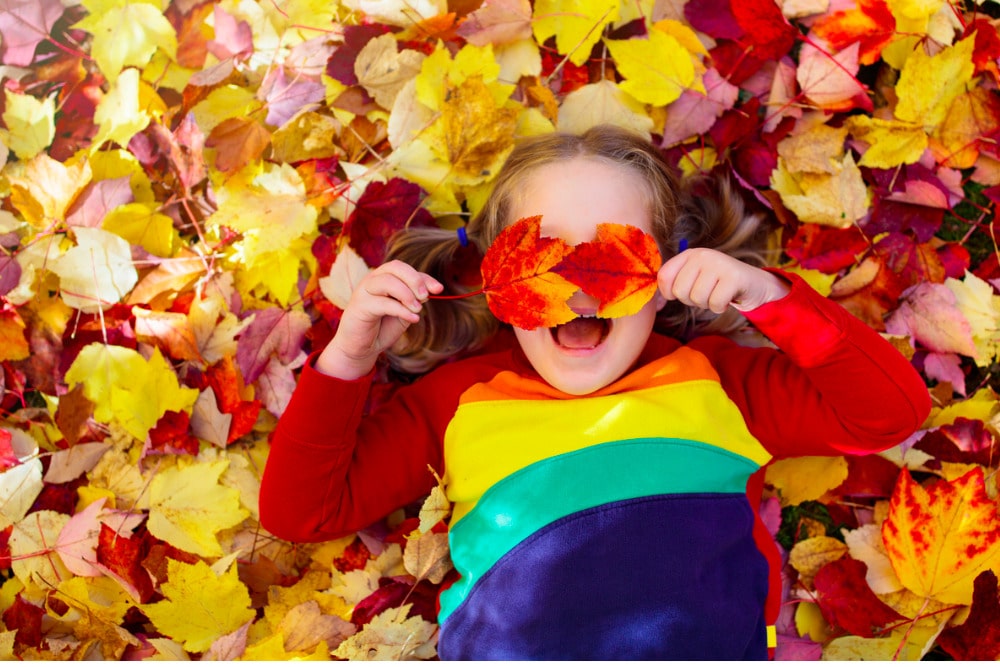 It’s that time of year: the air is getting crisp and cool, the leaves are beginning to change color and it’s time to get back to school. Autumn is here!
It’s that time of year: the air is getting crisp and cool, the leaves are beginning to change color and it’s time to get back to school. Autumn is here!
Below you’ll find some fun and crafty fall projects for kids, along with suggestions on making autumn-themed class books that will have your elementary school students engaged and excited for the season.
Kindergarten and First Grade
It’s Turkey Time
One project that is sure to be fun for your early elementary school students is drawing turkeys. All they’ll need is some paper for drawing, markers in fall colors (like orange, yellow and red) and their own little hands.
Have your students lay one hand flat on a piece of paper and use their other hand to trace the hand and fingers on the paper from one side of their wrist to the other. This will create the basic shape of a turkey in profile, with the thumb outline being the head, and the outline of the fingers being the basis of the turkey’s feathers.
Next, have them add a line to connect where their tracing left off at the wrist, then add an eye and a beak to the head, and legs and feet at the bottom of the turkey’s body. Finally, ask them to fill in the feathers and finish coloring in the turkey however they like. They can even use a red marker to draw a squiggly turkey’s wattle dangling down from the side of its head.
PROJECT IDEA
Drawing the turkey is fun but giving the turkey a story is even more fun! In addition to drawing the hand turkey, have your students create a short story about the turkey’s life. They can talk about what a day in the life of a turkey is like or come up with a crazy story about an event that happened to the turkey. Whether they want to include the stress of being a turkey around Thanksgiving is up to them. Once your students have their drawing and turkey stories, you can publish them in a holiday-themed classbook like the ones we have here!
Make Your Own Pumpkin Patch

Another fun way to get your students excited about fall is drawing or painting pumpkins to create their own pumpkin patch. They can make the basic shape of a pumpkin by tracing their fist, knuckles down, on a piece of paper (similar to the turkey-drawing exercise above, but using their knuckles to create the bumps at the top of the pumpkins).
Next, they can fill in the pumpkin shapes with more orange using markers, and then use a brown color to make a stem at the top of each pumpkin in the center of its bumps. As a finishing touch, have your students use a green color to draw or paint leaves sprouting out near the stems of their pumpkins, and to create squiggly lines connecting their pumpkins on a vine. Have them practice counting the number of pumpkins and leaves in their pumpkin patch.
PROJECT IDEA
Have your students name their pumpkins and create an acrostic poem describing their pumpkin’s personality. For example, the name Jack could be Jolly, Ample, Curious and Kind. Your students will come up with descriptive words based on the letters in their pumpkin’s name which makes this a fantastic and fun vocabulary exercise! Once your students have their acrostic poems and pumpkin drawings, you can publish their work in a classbook that they will treasure forever.
Create a Class Book for the Change of Seasons
Autumn is a wonderful time to talk to your early elementary school students about colors and seasons, and the perfect time to make a class book to celebrate the change from summer to fall. Have your students brainstorm words to describe what happens when the seasons change at this time of year, then have them write down those words and decorate their own pages to eventually put together into a class book.
Second and Third Grade

Once again, autumn is the perfect time to discuss what happens when the seasons change from summer to fall, and to introduce your mid-level elementary school students to concepts like chlorophyll in plants, and why the leaves change color and fall. Have your students collect leaves and any other fall materials (like small twigs, acorns and pumpkin seeds) that they find outside for inspiration and for use in the following two arts and crafts projects.
Create a Class Book About Autumn (and Why It’s the Best Season or Not)
After your class discussions about the changing of the seasons, and how and why leaves change color and fall, your students should be ready to write about what autumn means to them. Using class book pages, have them each write their own persuasive arguments about why fall is the best season—or, if they like another season better, have them write about why they like that other season better in comparison to autumn. After having your students write and decorate their pages, these can be combined to make a seasonal class book.
Create a Seasonal Masterpiece with Watercolors, Salt and Glue
For this project, your students will need the following supplies:
- Pencil
- Watercolor paper
- Watercolor paints
- Glue
- Salt
Using the real leaves they collected for inspiration, have your students use their pencils to draw several different leaves on a piece of watercolor paper. Once they’re done, have them use the glue to outline each of their leaf drawings. Next, while the glue is still wet, have your students pour salt over the outlines, eventually shaking off the excess salt into the trash. Then, before the glue and salt have dried, have your students use their watercolor paints to dot colors on top of the outlines. They’ll be amazed at the beautiful way the colors spread along their leaf outlines, and the result will be a wonderful piece of art. This will also be a great time to discuss chlorophyll in leaves.
Make Falling Leaf Art
To make falling leaf art, have your students use the same leaves they collected and used for inspiration for their watercolor piece, along with any other fall materials they may have found outside. For this project, all they’ll need is those natural materials and a large sheet of contact paper taped to the ground with the sticky side up.
Next, after discussing why it is that fall leaves indeed do fall to the ground, have your students let their fall materials go over the contact paper in whichever way they choose. They can then make predictions about which materials will stick to the paper when it’s lifted. Then lift the contact paper up and see what sticks—which will be the perfect segue into talking about weight and gravity. After a brief discussion, have your students put the contact paper back down and put any finishing touches they might like to add to this now ready-to-hang piece of art.
Fourth and Fifth Grade

Create a Class Book of Seasonal Haikus
Creating a class book of haikus with your upper elementary school students is a wonderful way for them to reflect on their thoughts and feelings about the fall season, for them to practice their writing skills, and for you to create an autumnal keepsake with your class. Haikus are a form of Japanese poetry and are often written about nature so they are a perfect project for fall reflection. Here is a great worksheet to help your students when learning about the structure of Haikus.
PROJECT IDEA
Have each of your students write a haiku about fall on their writing page from your classbook kit a separate class book page. Once they’ve written their poems and added any decorations or illustrations they’d like to, put the pages together to create a class book of seasonal poetry for the fall. They will be able to look back on their classbooks for years to come and remember being a young writer in elementary school!
Make a Fall Leaf Picture Frame or Wreath
As a fun art project, have your upper elementary school students decide if they’d like to make a fall leaf picture frame or a wreath. To make a picture frame, students can use a plain, undecorated frame (such as from a craft store) or even cut a frame out of cardboard. For the wreath, they can use a paper plate with the center cut out, or cut a circle from cardboard and then cut the center out of that.
Using cardboard or construction paper, have them create a stencil (or two or three) that they can use to trace leaves onto other pieces of construction paper and then cut them out. Then, they can use markers to color the background of their frame or wreath, and use glue to affix the construction-paper leaves to those backgrounds.
To add a special, shimmery touch, your students can write the year or another message on their frame or wreath with a marker, and then outline that and/or their fall leaves with glue, then sprinkle glitter over the project. Once that’s dry, they can shake off the excess glitter into the trash, and they’ll have a lovely new decoration to hang up in celebration of fall.
Discover How Leaves Change Color
For this engaging science project that explores the colors and chlorophyll of fall leaves, your students will need the following supplies:
- Pot of water for boiling*
- Rubbing alcohol
- Four small, clear containers
- Four different colored leaves (preferably green, yellow, brown and red, if possible)
- Tongs*
*It’s best if the water is boiled and the tongs are used by an adult or with adult supervision.
First, have your students (or an adult) gather their leaves and fill the pot of water, then set it to boiling. Once the water is boiling, they’ll add the leaves to the pot for five minutes. During this time, they should fill up the small, clear containers with rubbing alcohol.
Next, have an adult use the tongs to remove the leaves and place each of them in one of the containers of rubbing alcohol, sorting the leaves by color. Have your students take note of the color of the rubbing alcohol, then check back throughout the day to observe if the color has changed.
Let the leaves sit in the containers with the rubbing alcohol overnight, then have your students come back in the morning and make note of their observations: Has the color of the rubbing alcohol changed? If so, how much? What is the difference between each of the different colors of leaves? You may want to have them leave the leaves in place for one more day and night, making note or their observations.
Finally, discuss the changes that your students observed in this science project as a class.
Looking for additional resources? Our online Teacher’s Lounge is an excellent place for you to find more helpful tips on improving your students’ writing. Head over to sign up and receive a FREE Classbook Publishing Kit to make a special memory for your class.






